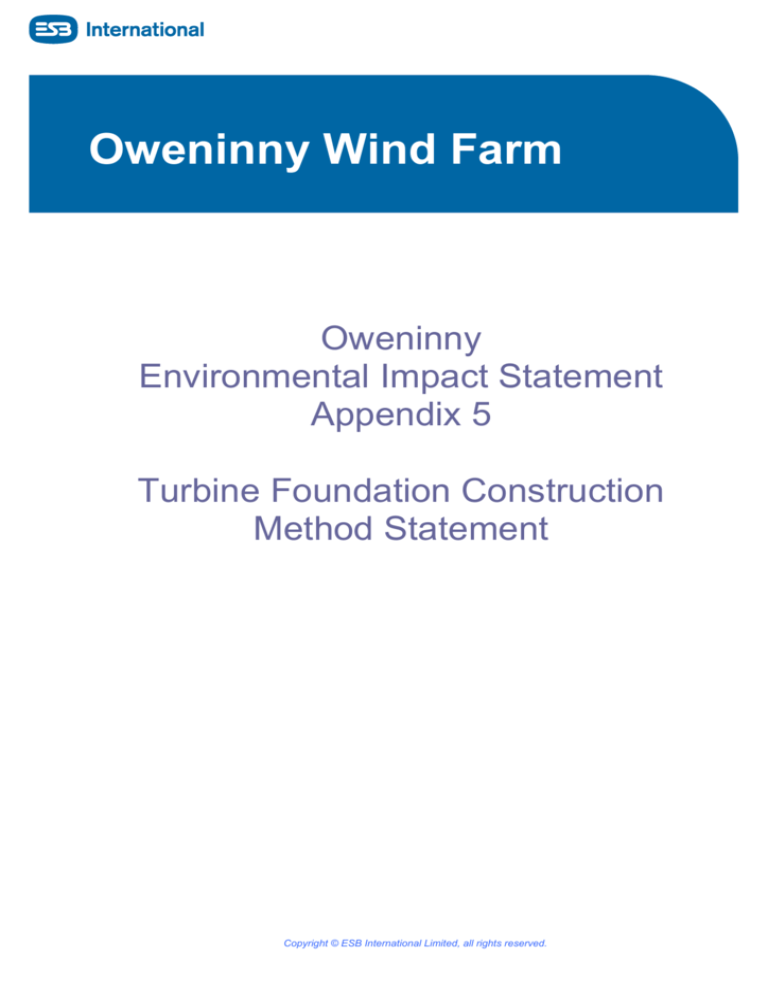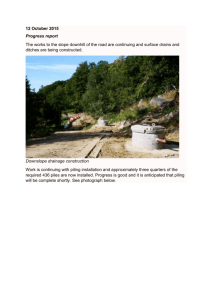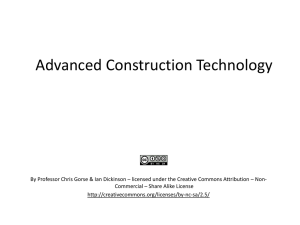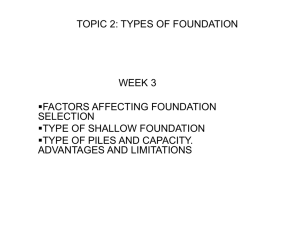
Oweninny Wind Farm
Oweninny
Environmental Impact Statement
Appendix 5
Turbine Foundation Construction
Method Statement
Copyright © ESB International Limited, all rights reserved.
Farm
Contents
1
2
3
4
Introduction
1
1.1
1
General
Preliminary Site Investigation
2
2.1
General
2
2.2
Scope of Works
2
2.3
Ground Conditions
2
Foundation Design
4
3.1
General
4
3.2
Foundation Selection
4
3.3
Pile Options
5
3.3.1
Driven Piles
5
3.3.2
Continuous Flight Auger (CFA) Piles
5
3.3.3
Bored Displacement Piles
6
3.3.4
Rotary Piles
6
3.3.5
Odex Piles
6
Construction Sequence
7
4.1
General
7
4.2
Preliminaries
7
4.3
Plant/Equipment
7
4.4
Foundation Scheme 1 – Base bearing on ground
8
4.5
Foundation Scheme 2 – Base supported on piles into deep subsoils
8
4.6
1m)
Foundation Scheme 3 – Base supported on piles with short rock socket (≈
10
4.7
Foundation Scheme 4 – Base supported on piles requiring embedment into
rock (≈ 4m)
10
4.8
Pile testing
10
5
Environmental Controls
11
6
Summary
12
i
15/06/2013
1
Introduction
1.1
General
The following document presents the Construction Method Statement for the
foundations for the wind turbines at the proposed wind farm at Oweninny,
Bellacorick, Co. Mayo.
The development will consist of 112 No. turbines on the site.
The foundations will most likely consist of piled foundations and / or ground
bearing foundations depending on the ground conditions determined at each
turbine location.
The report provides a method statement on the proposed piling techniques
suitable for the project, how the piles shall be constructed and how the bases shall
be constructed.
1
15/06/2013
2
Preliminary Site Investigation
2.1
General
Preliminary site investigations have been carried out at turbine locations on the
Oweninny site. The purpose of the preliminary site investigations was to broadly
determine the ground conditions across the site. This information is then used to
identify the most likely foundation solution for the structures on the site including
roads, hardstandings, turbine foundations and ancillary buildings. The information
that will be provided from a detailed site investigation will identify the locations
where piling will be required, the most appropriate piling technique to be employed
and the required pile size and depth.
This method statement covers the approach and work methodology which will be
used for concrete foundation construction and for concrete piling operations where
required.
2.2
Scope of Works
The preliminary site investigation consisted of 10 No. shell and auger boreholes, 9
rotary coreholes and approximately 1 No. trial pit near each proposed turbine
location.
The shell and auger boreholes provide valuable information on the upper subsoil
strata such as soil strength and permeability. Shell and auger boreholes were
carried out to between 7.5m below ground level (bgl) and 15m bgl.
The rotary coreholes provide information on the deeper harder strata such as the
bedrock. Coring commenced at the deepest point on each shell and auger
borehole and in most instances extended to prove the bedrock depth by a
minimum of 4m.
The trial pits allow a visual inspection of the ground at each turbine location to
determine the depth of peat and to identify the requirements of the detailed site
investigation at each proposed turbine location at the construction phase.
2.3
Ground Conditions
Ground conditions at the site generally consist of peat over glacial deposits
interbedded with glacio-fluvial deposits over bedrock.
The peat across the site has been largely well harvested which results in relatively
shallow peat depths recorded in many areas.
The glacial deposits generally consist of soft to very stiff boulder clay grading to
medium dense to dense gravels. These are generally over consolidated strata and
interbedded with what are most likely to be glacio-fluvial deposits consisting of
loose to medium dense fine sand.
Bedrock has been geologically logged and is characterised as Sandstone or
Mudstone.
The following table 1 briefly summaries the ground conditions at the site based on
the rotary coreholes and boreholes:
2
15/06/2013
Stratum
Depth to top (m bgl)
Thickness (m)
0.0
0.0 - 3.5
Glacial Till
0.4 - 3.5
7.0 - 22.65
Glacio-Fluvial
Deposits
0.5 - 1.5
0.5 - 1.0
8.5 - 23.15
-
Peat
Bedrock
Table 1 – Summary of Ground Conditions
Ground water was observed in most trial pits and boreholes. In the permeable
materials water ingress was rapid and at a shallow depth. It is therefore
anticipated that the water table will be high across the site.
3
15/06/2013
3
Foundation Design
3.1
General
The function of the turbine foundation is to transfer all the loads i.e. vertical and
horizontal forces and moments generated by the turbine through a reinforced
concrete base to the ground. The reinforced concrete base will be designed to
distribute the loads to the ground directly or to distribute the loads to piles which
then transfer the load to deeper soil strata depending on the subsoil conditions.
In general the foundation bases will consist of circular or octagonal (in plan)
concrete base with a central circular raised plinth which will be used to anchor the
turbine tower at its base.
Where ground conditions indicate that piling is required the piles to be constructed
will be considered large diameter piles and will range in the order of 600mm to
1200mm diameter.
3.2
Foundation Selection
The foundation scheme selection at each turbine location will be based on the
ground conditions and site and environmental considerations. Further
investigations at each turbine location will determine the ground conditions. Either
shallow ground bearing foundations or piled foundations will be used.
Where suitable founding strata are located at shallow depths above the water
table or where ground water can be comfortably controlled by conventional
pumping, shallow ground bearing foundation bases will be designed and
constructed. In all other areas piled foundations will be used to transfer the loads
from the base to the ground.
If suitable ground conditions are present for shallow foundations at the turbine
bases located in areas adjacent to the environmentally designated areas (around
the Bellacorick Iron Flush SAC, Lough Dahybawn SAC and in the eastern area of
the site in the Formoyle Iron Flush catchment area) shallow foundations will be
considered. However where the water table requires lowering in these areas, in
order to construct the base, then only a piled foundation solution will be
considered such that pumping of groundwater water will be avoided.
Given the depth of peat across the site, the high static water level and the poor
strength quality of most of the shallow subsoils it is likely that most of the turbines
will be supported on piles.
The piling options have been categorised into three, namely:
a) those with embedment in the deep glacial till (long piles) i.e. where rock is so
deep that resistances can be met by the subsoils alone,
b) those requiring short rock sockets ≈ 1m (medium length piles) i.e. will apply to
conditions where rock is reasonably shallow and penetration into rock is
required to achieve the required load capacity
c) those requiring deep rock sockets ≈ 4m (short pile) i.e. where the rock is
shallow.
The final design of the specific foundation type at each turbine location will be
determined by a detailed site investigation which will be carried out as part of the
4
15/06/2013
detailed design process prior to construction and with reference to its proximity to
environmental designated areas.
The piles supporting the foundation bases will be required to support the
compression, tension and horizontal loads from the turbines.
3.3
Pile Options
Various pile options have been considered for this development. Given the
magnitude of the loads that will be transferred to the piles, mini piles are not
suitable for the development.
Large reinforced concrete piles will be required to support the loads. These types
of piles can be constructed in a number of ways such as; bored Continuous Flight
Auger (CFA), bored displacement, rotary, driven and ODEX piles.
The following sections outline the advantages and disadvantages for the various
piling options considered with respect to this site. It may result that a combination
of the options below may be required at the site given the irregular nature of the
subsoil/rock depths and thicknesses.
The detailed design of the piles will be responsibility of the piling contractor.
3.3.1
Driven Piles
Driven piles have been considered for this development however depending on
the findings of the detailed site investigation they may not be considered suitable
on this site. Driven piles cause relatively large ground borne vibrations which
could lead to nuisance noise issues however this is unlikely to be an issue at this
site given the distance to receptors. Driven piles are generally driven to a hard
stratum like rock, very stiff clay or dense gravels. However they also can “refuse”
at shallower depths than required if they encounter large boulders during driving.
The preliminary site investigation revealed that shallow boulders (circa. 8.0m bgl)
were encountered in some shell and auger boreholes resulting in termination of
the borehole at these depths. There is also a potential that driven piles at this site
may also terminate in similar ground conditions at these depths and therefore not
develop the required resistance in the ground to support the loads.
As the piles employed to support the foundation bases may be required to support
both compression and tension loads then the pile will need to achieve a suitable
depth to resist the tension (uplift) forces. In some instances this will require that
the piles are “socketed” into the bedrock. This cannot readily be achieved with a
driven pile.
3.3.2
Continuous Flight Auger (CFA) Piles
CFA piles have also been considered for this project. CFA piles are the fastest
bored pile technique in terms of actual construction. CFA piles are likely to refuse
on top or marginally into the bedrock which similarly to the driven pile will be
unsuitable where deep embedment into the rock will be required. This technique
will however be suitable for other situations i.e. embedment into deep stiff/dense
subsoils.
CFA piles will also be able to penetrate the boulders encountered in the boreholes
and hence are considered to be suitable for the site where embedment into deep
stiff/dense subsoils is possible.
5
15/06/2013
3.3.3
Bored Displacement Piles
Bored displacement piles have been considered for the proposed site, in particular
for the piles that will be constructed onto rock or into the deep subsoil. However
displacement piles will struggle to penetrate the deep stiff subsoils and are likely
to unsuitable for construction on this project.
3.3.4
Rotary Piles
Rotary piles have also been considered for this project. The advantage of these
piles is that the rig/auger will have the capability of being able to penetrate the
medium sized shallow boulders and the stiff/dense subsoils.
Where required by the design, rock sockets can be developed by using an
alternative rock boring drill bit.
During drilling a temporary casing supports the pile hole until the reinforcement
and concrete has been placed.
This pile option would be suitable for the piles where bearing into the rock is
required or rock is very deep with the pile gaining resistance from the dense
glacial tills at depth.
3.3.5
Odex Piles
Odex piles are specifically used for the construction of piles into rock or very hard
strata. This piling technique will be capable of penetrating the rock, where shallow,
in order to develop the required loads as it uses an Odex drill bit.
The piles are constructed using a temporary casing which follows the Odex drill bit
to the base of the hole. This supports the pile hole until the reinforcement and
concrete has been placed.
While there is a risk of the Odex drilling being affected by the stiff clays this can be
overcome by using alternative methods to progress the pile hole to the top of the
rock. From thence the Odex drilling can progress the hole.
6
15/06/2013
4
Construction Sequence
4.1
General
The following section provides the construction sequence for the four foundation
schemes:
•
Base bearing on ground
•
Base supported on piles into deep subsoils
•
Base supported on piles with short rock socket
•
Base supported on piles requiring embedment into rock
The works associated with the base formation and construction is discussed as
well as the pile construction.
4.2
Preliminaries
All construction works will be undertaken in accordance with the Erosion and
Sediment Control Plan developed for the project. Turbine foundation construction
will occur following construction of access tracks and crane hardstands. As part of
the construction of these, drainage and sediment control works comprising
settlement ponds and drainage channels will be established. Runoff and
dewatering from any excavation works associated with foundation construction will
be directed to the drainage control system through the settlement ponds.
All equipment will be provided with spill trays for vehicle refuelling purposes and
crews will be provided with spill cleanup kits and trained in their use.
The following preliminaries are also required in order to facilitate the construction
of the piles. These are generally provided by the main contractor.
4.3
•
Water supply
•
Suitable Access
•
Firm level working piling platform
•
Setting out points
•
Removal of obstructions
Plant/Equipment
The exact plant/equipment for the pile construction will depend largely on the
method employed for the works i.e. different piling techniques as mentioned
above will have different plant however in broad terms the following
plant/equipment will be provided:
•
Tracked piling rig
•
Drill augers/drill heads (Odex, Toothed Open Barrel for rock socket
construction or similar)
•
Excavator to remove any spoil developed during the pile construction
•
Prefabricated reinforcement cages
•
Concrete pump
•
Compressor
7
15/06/2013
4.4
•
Stores Container
•
Bunded Fuel Tank
•
Site Cabin
•
Concrete Delivery Truck
Foundation Scheme 1 – Base bearing on ground
The first foundation option will consist of a conventional base supported directly
on the exposed ground. This will be constructed as per any typical ground bearing
foundation.
Firstly the ground will be excavated to a suitable founding stratum. This will
typically be within the upper 3m however the detailed site investigation will confirm
this. Excavated material will be side cast to a specified depth in suitable locations
or used for landscaping at the turbine locations. The suitability of the founding
stratum will be confirmed by the site engineer. Where necessary, temporary
pumps and sumps may be required to maintain a dry, clean formation. Pumped
water will be directed to the settlement ponds prior to entering the drainage
system.
A blinding layer of lean mix concrete shall then be placed on to the formation in
order to protect it from degradation due to rain and to provide a firm clean level
platform for the reinforcement to be tied for the base.
Cover spacers will be laid on the formation and the reinforcement will then be tied
in accordance with the detailed design drawings and rebar schedules. The
required anchor detail for the turbine tower will also be included at this stage. The
side shutters with cover spacers will then be erected.
The base will then be cast in the sequence stipulated by the structural design
engineer which is likely to consist of 2 pours; a lower base pour and an upper
pedestal pour. Each pour will be completed within one day. Monitoring of the
concrete throughout the curing process will be carried out on a continual basis.
The upper pedestal pour will be carried out approximately 3 weeks after the lower
base pour.
As the concrete is being poured cube samples will be taken and cured in a special
temperature controlled curing tank for compressive strength testing.
When the concrete has been cured for the required period the base shutters will
then be stripped and excavation will be suitably backfilled with granular material to
tie in with the required level of the hardstanding for the cranage of the turbine
tower.
4.5
Foundation Scheme 2 – Base supported on piles into
deep subsoils
This foundation option will include a base similar to that discussed in 4.4
supported on approximately 35 No. 600-1200mm diameter piles. Firstly the
surface layer of the ground will be stripped aside. Excavated material will be side
cast to a specified depth in suitable locations or used for landscaping at the
turbine locations. A piling platform will be constructed above the groundwater
level. No dewatering will occur at the turbine locations in areas adjacent to the
environmentally designated areas (around the Bellacorick Iron Flush SAC, Lough
8
15/06/2013
Dahybawn SAC and in the eastern area of the site in the Formoyle Iron Flush
catchment area).
The function of the piles will be to transfer load to the deep stiffer subsoils and to
facilitate the construction of the base above the ground water table.
The piles will be arranged in a number of layers in a radial fashion beneath the
base. While the final piling option will be determined on completion of the detailed
site investigation the following outlines the piles in this case will consist of CFA
piles or rotary piles.
CFA Option
Piling Platform
The construction sequence for this scheme will commence with the construction of
a piling platform to the required pile cut-off level. The piling platform will consist of
a compacted stone fill make up which will be designed based on the rig size and
ground conditions at each turbine location determined during the detailed site
investigation. At each turbine location it is proposed to excavate the peat to locate
a suitable formation stratum for the piling platform. Based on the preliminary site
investigation it is generally not envisaged that the ground water table will be
encountered above a suitable formation level. Where this is not the case and
ground water ingress cannot be comfortably controlled by conventional pumping
or at the turbine locations adjacent to the aforementioned environmentally
sensitive areas, an alternative piling platform solution will be considered such as a
floating platform.
The piling rig will then commence by setting up at the first pile location. Using the
CFA method piles will be bored to the required depth using a continuous auger.
There will be ongoing monitoring of the flighting and penetration rates in order to
ensure that over flighting does not occur during the boring. Once the auger has
reached the required pile depth, concrete will be pumped by means of a tremie
pipe down the stem of the auger. The extraction rate of the pile will be such that
the rate of concrete flow will fill the annulus of the pile hole. This will be monitored
so as to ensure that the pile will be protected from collapse.
When the pile hole has been filled with concrete to the required depth and the
auger fully retracted the rig is moved back slightly from the hole and the rig is then
used to crane a prefabricated rebar cage into the pile hole. The prefabricated
cage is fitted with circular spacers to ensure that the required cover is provided to
the rebar cage in the hole. Spoil is then removed and the rig sets up at the next
pile location. Rebar will protrude beyond the pile cut off level to tie into the new
base.
The next pile location will be a minimum of 3 pile diameters away from the
previous to ensure that there is no interference between the ‘wet’ pile holes.
Rotary Pile Option
Using the rotary pile technique the hole is bored by means of a short auger which
is trailed by a temporary casing. As the auger fills and penetrates the ground the
casing trails the auger and maintains support to the pile hole. Once the auger is
filled the auger is retracted and the soil material is removed. This sequence is
repeated until the pile hole is bored to the required depth.
9
15/06/2013
When the hole is bored to the required depth the prefabricated reinforcement cage
is then installed with circular spacers in order to ensure the correct cover is
provided to the rebar. Concrete is then pumped in to the hole and the spoil is
removed from the area. Rebar will protrude beyond the pile cut off level to tie into
the new base. The temporary casing is then removed.
The next pile location will be a minimum of 3 pile diameters away from the
previous to ensure that there is no interference between the ‘wet’ pile holes.
Base construction
Once all the piling for base has been completed the piles are checked to ensure
that their cut off level is coincident with the required base of the foundation. If this
is not the case some pile head cutting may be required. When all piles are to the
required level the area is lean-mixed and the foundation base rebar is tied and
concrete is poured as per Scheme 1.
4.6
Foundation Scheme 3 – Base supported on piles with
short rock socket (≈ 1m)
This option involves the same construction sequence as scheme 2. In this
instance the piles will be constructed to rock level or with a marginal rock socket
(approximately 1-1.5m).
Additional works beyond the previous scheme consist of changing of the auger
type to ensure that the 1m penetration into the intact rock head is achieved once
the rock level is encountered. This will be carried out be means of an open barrel
drill bit or Odex drill bit. Temporary casing will not be required in this stratum.
4.7
Foundation Scheme 4 – Base supported on piles
requiring embedment into rock (≈ 4m)
This option involves the same construction sequence as scheme 3 with the
exception that the rock socket will be extended to approximately 4m into the intact
rock.
4.8
Pile testing
Static and dynamic pile load testing will be carried out at the site prior to base
pour. Static and dynamic testing will be carried out in accordance with IS EN 1997
in order to confirm the ultimate limit state and serviceability limit state of the piles.
The number and location of static load tests will be determined on completion of
the detailed site investigation and the findings therein.
All piles will be integrity tested.
During construction of the piles drilling records will be maintained by the piling
subcontractor. Drilling records will record information such as rate of penetration,
difficulty/ease of drilling, depth etc. which will enable the operative of the rig
achieve the required embedment and thus load capacity.
10
15/06/2013
5
Environmental Controls
The following environmental controls will be put in place during foundation
construction and piling operations:
•
Prior to construction of the wind turbine base the drainage and sediment
control plan will be fully implemented with the required settlement pond and
interceptor drains put in place.
•
Excavated material will not be stockpiled within 10m of any watercourse and
will be side cast on adjacent lands to a specified depth in a controlled manner.
•
All fuels and oils will be stored in bunded storage areas.
•
Spill trays will be provided for vehicle refuelling purposes and spill cleanup kits
and training in their use will be provided to construction crews
•
Spoil from piling operations shall be placed upstream of a cut-off drain and
settlement pond as part of the drainage control system. Alternatively this
material will be placed in the area of the proposed borrow pit.
11
15/06/2013
6
Summary
The following briefly summaries the contents of this report:
•
Preliminary site investigations have been carried out at the turbine sites of
Oweninny Wind Farm in order to determine the likely foundation requirements
for access roads and turbines.
•
Two construction methods for turbine foundation are envisaged, base
foundation or piled foundation
•
The site investigation reveals that due to a high static water table and the
depth to suitable bearing strata pile foundations are the most suitable
foundation solution for the majority of turbine foundations.
•
A number of options have been considered including CFA, Rotary Piles,
Displacement Piles, Driven Pile and Odex Piles.
•
The final pile type selection for each turbine location will dependant on ground
conditions.
•
The construction sequence for piles of varying lengths have been presented
as discussed.
•
The appropriate foundation solution for each turbine location will be based on
the detailed site investigation which will involve carrying out boreholes at each
turbine location.
•
A static and dynamic testing scheme for the piles will be developed based on
the detailed site investigation.
•
Environmental controls will be put in place prior to turbine base construction
12
15/06/2013








